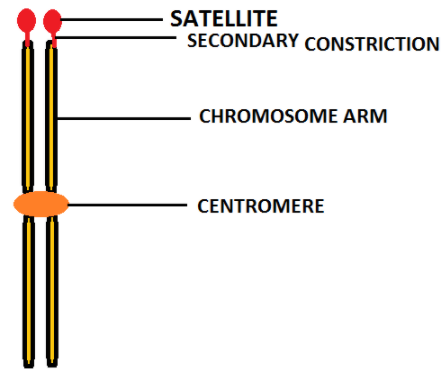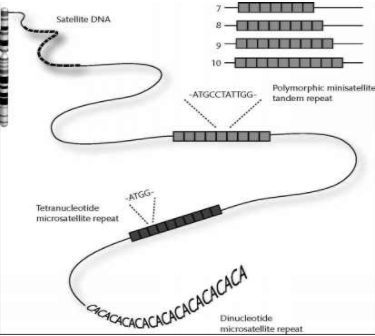
A SAT chromosome is one
A) Which has a chromatic body attached to the secondary constriction
B) Which has only secondary constriction
C) Which has only primary constriction
D) None of these
Answer
573.9k+ views
Hint: SAT chromosome stands for satellite chromosomes. The chromosome number 13, 14, 15, 21 and 22 are examples of satellite chromosomes.
Complete answer:
Satellite chromosomes were first identified by Russian cytologists in the twentieth century. SAT chromosomes have a segment that is separated from the main body of the chromosome by secondary constriction. These secondary constrictions act as the identifying markers. At the metaphase more secondary constricts can be seen other than centromere. It appears to be attached to chromosomes by a thread of chromatin. These secondary constrictions which are present on the chromosome mark the site of the Nucleolar organizer region (NOR). This is the same region that contains multiple copies of 18 S and 28 S ribosomal genes. These ribosomal genes synthesize ribosomal RNA which is further required by the ribosomes.
The SAT chromosome has more heterochromatin in it. Heterochromatin is a tightly packed form of DNA. At metaphase, the satellite chromosome is appeared to be attached to the rest of the body of the chromosome by a thread of chromatin.
Option B does not talk about the chromatin body hence wrong.
Option C talks about the presence of primary constriction which is not true about the SAT chromosome.
The correct answer is (A). The reason for this answer to be is that satellite chromosomes are identified by the secondary constructs which have chromatin bodies.

Note: Chromosomes that contain satellites are called SAT Chromosomes. They have chromatinic bodies which are identified at the metaphase.

The Satellite DNA
Complete answer:
Satellite chromosomes were first identified by Russian cytologists in the twentieth century. SAT chromosomes have a segment that is separated from the main body of the chromosome by secondary constriction. These secondary constrictions act as the identifying markers. At the metaphase more secondary constricts can be seen other than centromere. It appears to be attached to chromosomes by a thread of chromatin. These secondary constrictions which are present on the chromosome mark the site of the Nucleolar organizer region (NOR). This is the same region that contains multiple copies of 18 S and 28 S ribosomal genes. These ribosomal genes synthesize ribosomal RNA which is further required by the ribosomes.
The SAT chromosome has more heterochromatin in it. Heterochromatin is a tightly packed form of DNA. At metaphase, the satellite chromosome is appeared to be attached to the rest of the body of the chromosome by a thread of chromatin.
Option B does not talk about the chromatin body hence wrong.
Option C talks about the presence of primary constriction which is not true about the SAT chromosome.
The correct answer is (A). The reason for this answer to be is that satellite chromosomes are identified by the secondary constructs which have chromatin bodies.

Note: Chromosomes that contain satellites are called SAT Chromosomes. They have chromatinic bodies which are identified at the metaphase.

The Satellite DNA
Recently Updated Pages
Master Class 12 Business Studies: Engaging Questions & Answers for Success

Master Class 12 Economics: Engaging Questions & Answers for Success

Master Class 12 English: Engaging Questions & Answers for Success

Master Class 12 Maths: Engaging Questions & Answers for Success

Master Class 12 Social Science: Engaging Questions & Answers for Success

Master Class 12 Chemistry: Engaging Questions & Answers for Success

Trending doubts
What is meant by exothermic and endothermic reactions class 11 chemistry CBSE

Which animal has three hearts class 11 biology CBSE

10 examples of friction in our daily life

One Metric ton is equal to kg A 10000 B 1000 C 100 class 11 physics CBSE

1 Quintal is equal to a 110 kg b 10 kg c 100kg d 1000 class 11 physics CBSE

Difference Between Prokaryotic Cells and Eukaryotic Cells




